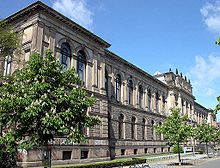Technical University of Braunschweig
Technische Universität Braunschweig | |
 | |
Former names | Collegium Carolinum |
|---|---|
| Type | Public |
| Established | 1745 |
| Endowment | € 81,100,000 third-party funds (2014) [1] |
| Budget | € 311,000,000 (2014) [1] |
| President | Jürgen Hesselbach [de] |
Academic staff | 1,800 (2011) [2] |
| Students | 19,500 (WS 2015/16) [2] |
| Location | , , 52°16′25″N 10°31′47″E / 52.27361°N 10.52972°E |
| Affiliations | TU9, CESAER, PEGASUS |
| Website | tu-braunschweig.de |


The TU Braunschweig (Template:Lang-en) is the oldest Technische Universität [de] (comparable to an institute of technology in the American system) in Germany. It was founded in 1745 as Collegium Carolinum[3] and is a member of TU9, an incorporated society of the most renowned and largest German institutes of technology. It is commonly ranked among the top universities for engineering in Germany. Today it has about 19,000 students, making it the third largest university in Lower Saxony after the University of Göttingen and the University of Hanover. Research projects include micro air vehicles, hybrid engines, and digital video broadcasting.
Name
Its complete name is Technische Universität Carolo-Wilhelmina zu Braunschweig. Translating the name into English is discouraged by the university, but proposed translations are University of Braunschweig - Institute of Technology or Braunschweig Institute of Technology[4] (and University of Brunswick - Institute of Technology or Brunswick Institute of Technology if translating completely into English). While the word "technology" in its name implies a focus on science and engineering, it is still a university in the sense that it represents a wide range of subjects. It is subdivided into six schools with different degree programmes and specialisations.
Departments
- Carl Friedrich Gauß School - Faculty for Mathematics, Computer Science, Business Administration, Economics, and Social Sciences
- Life Sciences
- Biology
- Biotechnology
- Chemistry
- Food Chemistry
- Pharmacy
- Psychology
- Architecture, Civil Engineering, and Environmental Sciences
- Architecture
- Civil Engineering
- Civil Engineering and Business Administration
- Environmental Engineering
- Geoecology
- Mechanical Engineering
- Mechanical Engineering (Aeronautical, Automotive, Industrial, Energy & Process)
- Mechanical Engineering and Business Administration
- Biological engineering
- Electrical Engineering, Information Technology, Physics
- Electrical Engineering
- Information Technology
- Physics
- Humanities and Educational Sciences
Governmental testing and certification work
Commonly known in Germany, and particularly in the field of passive fire protection, as "TU Braunschweig", its iBMB Institute has been accredited by the German Institute for Building Technology (Deutsches Institut für Bautechnik) and has, for decades, performed public testing for the purpose of establishing fire-resistance ratings of products and systems for manufacturers. iBMB also assists the DIBt in third-party vendor inspections (product certification) and quality control testing, in an effort to maintain DIBt approvals. iBMB was also instrumental in leading the Eureka project, which has become a guideline for building codes and regulations governing fire protection measures for traffic tunnels.
-
iBMB / TU Braunschweig administration building
-
Special torsion test rig at iBMB / TU Braunschweig, for use in full scale fire testing of passive fire protection systems.
-
Full scale floor furnace at iBMB / TU Braunschweig, for use in full scale fire testing of passive fire protection systems
Alumni
Current and former members of the TU Braunschweig include mathematician Carl Friedrich Gauss, Nobel Laureate Klaus von Klitzing, SAP-CEO Professor Henning Kagermann, truck engineer and entrepreneur Heinrich Büssing of Büssing AG, as well as renowned architect Meinhard von Gerkan.
See also: List of Braunschweig University of Technology people
Notes and references
- ^ a b "Budget" (PDF) (in German). Technische Universität Braunschweig. Retrieved 2016-01-12.
- ^ a b c d "TU Braunschweig in Zahlen" (in German). Technische Universität Braunschweig. Retrieved 2015-01-19.
- ^ Named after its founder Charles I, Duke of Brunswick-Wolfenbüttel.
- ^ PR Technische Universität Braunschweig. "English translation" (in German).
External links
- Braunschweig University of Technology
- Universities and colleges in Lower Saxony
- Universities and colleges in Germany
- Technical universities and colleges in Germany
- Organisations based in Braunschweig
- Buildings and structures in Braunschweig
- Educational institutions established in the 1740s
- 1745 establishments in the Holy Roman Empire
- Education in Braunschweig



